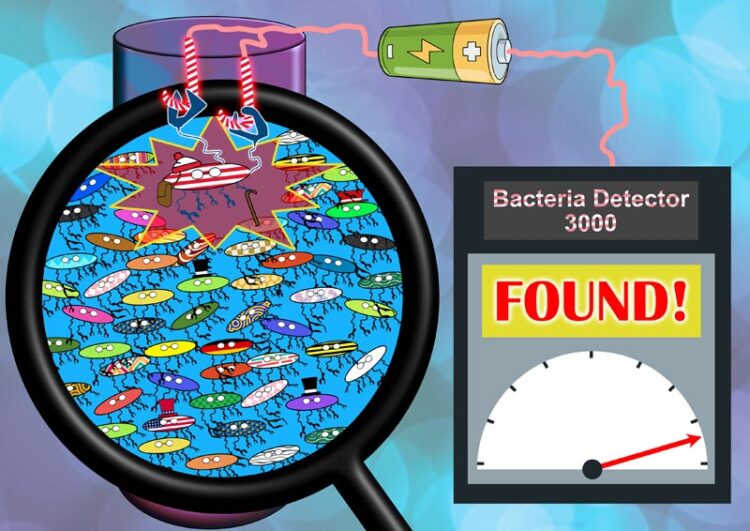Novel electrochemical sensor detects dangerous bacteria

By using a customized surface to bait the targeted pathogens, they separate by themselves from a mixture of many different bacteria. This makes it easy to detect them electrochemically.
Diagram: Sebastian Balser / GU
Researchers at Goethe University Frankfurt and Kiel University have developed a novel sensor for the detection of bacteria. It is based on a chip with an innovative surface coating. This ensures that only very specific microorganisms adhere to the sensor – such as certain pathogens. The larger the number of organisms, the stronger the electric signal generated by the chip. In this way, the sensor is able not only to detect dangerous bacteria with a high level of sensitivity but also to determine their concentration.
Each year, bacterial infections claim several million lives worldwide. That is why detecting harmful microorganisms is crucial – not only in the diagnosis of diseases but also, for example, in food production. However, the methods available so far are often time-consuming, require expensive equipment or can only be used by specialists. Moreover, they are often unable to distinguish between active bacteria and their decay products.
By contrast, the newly developed method detects only intact bacteria. It makes use of the fact that microorganisms only ever attack certain body cells, which they recognize from the latter’s specific sugar molecule structure. This matrix, known as the glycocalyx, differs depending on the type of cell. It serves, so to speak, as an identifier for the body cells. This means that to capture a specific bacterium, we need only to know the recognizable structure in the glycocalyx of its preferred host cell and then use this as “bait”.
This is precisely what the researchers have done. “In our study, we wanted to detect a specific strain of the gut bacterium Escherichia coli – or E. coli for short,” explains Professor Andreas Terfort from the Institute of Inorganic and Analytical Chemistry at Goethe University Frankfurt. “We knew which cells the pathogen usually infects. We used this to coat our chip with an artificial glycocalyx that mimics the surface of these host cells. In this way, only bacteria from the targeted E. coli strain adhere to the sensor.”
E. coli has many short arms, known as pili, which the bacterium uses to recognize its host’s glycocalyx and cling onto it. “The bacteria use their pili to bind to the sensor in several places, which allows them to hang on particularly well,” says Terfort. In addition, the chemical structure of the artificial glycocalyx is such that microbes without the right arms slide off it – like an egg off a well-greased frying pan. This ensures that indeed only the pathogenic E. coli bacteria are retained.
But how were the scientists able to corroborate that bacteria really were attached to the artificial glycocalyx? “We bonded the sugar molecules to a conductive polymer,” explains Sebastian Balser, a doctoral researcher under Professor Terfort and the first author of the paper. “By applying an electrical voltage via these ‘wires’, we are able to read how many bacteria had bonded to the sensor.”
The study documents how effective this is: The researchers mixed pathogens from the targeted E. coli strain among harmless E. coli bacteria in various concentrations. “Our sensor was able to detect the harmful microorganisms even in very small quantities,” explains Terfort. “What’s more, the higher the concentration of the targeted bacteria, the stronger the emitted signals.”
The paper is initial proof that the method works. In the next step, the involved working groups want to investigate whether it also stands the test in practice. Using it in regions where there are no hospitals with sophisticated lab diagnostics is conceivable, for example.
Picture download:
https://www.puk.uni-frankfurt.de/151323552?
Caption: By using a customized surface to bait the targeted pathogens, they separate by themselves from a mixture of many different bacteria. This makes it easy to detect them electrochemically.
Diagram: Sebastian Balser, Andreas Terfort Research Group, Goethe University Frankfurt
Wissenschaftliche Ansprechpartner:
Professor Andreas Terfort
Institute of Inorganic and Analytical Chemistry
Goethe University Frankfurt
Tel.: +49 (0)69 798-29181
aterfort@chemie.uni-frankfurt.de
Website: https://www.uni-frankfurt.de/53459866/Arbeitskreis_Prof__Andreas_Terfort
Twitter/X: @goetheuni
Originalpublikation:
Sebastian Balser, Michael Röhrl, Carina Spormann, Thisbe K. Lindhorst, Andreas Terfort: Selective Quantification of Bacteria in Mixtures by Using Glycosylated Polypyrrole/Hydrogel Nanolayers. ACS Applied Materials & Interfaces Article ASAP; https://doi.org/10.1021/acsami.3c14387
Media Contact
All latest news from the category: Life Sciences and Chemistry
Articles and reports from the Life Sciences and chemistry area deal with applied and basic research into modern biology, chemistry and human medicine.
Valuable information can be found on a range of life sciences fields including bacteriology, biochemistry, bionics, bioinformatics, biophysics, biotechnology, genetics, geobotany, human biology, marine biology, microbiology, molecular biology, cellular biology, zoology, bioinorganic chemistry, microchemistry and environmental chemistry.
Newest articles

Humans vs Machines—Who’s Better at Recognizing Speech?
Are humans or machines better at recognizing speech? A new study shows that in noisy conditions, current automatic speech recognition (ASR) systems achieve remarkable accuracy and sometimes even surpass human…

Not Lost in Translation: AI Increases Sign Language Recognition Accuracy
Additional data can help differentiate subtle gestures, hand positions, facial expressions The Complexity of Sign Languages Sign languages have been developed by nations around the world to fit the local…

Breaking the Ice: Glacier Melting Alters Arctic Fjord Ecosystems
The regions of the Arctic are particularly vulnerable to climate change. However, there is a lack of comprehensive scientific information about the environmental changes there. Researchers from the Helmholtz Center…



